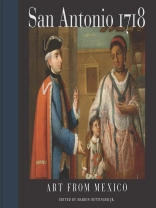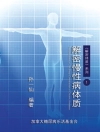Three hundred years ago San Antonio was founded as a strategic outpost of presidios and missions on the edge of northern New Spain, imposing Spanish political and religious principles on this contested, often hostile region. The city’s many Catholic missions bear architectural witness to the time of their founding, but few have walked these sites without wondering who once lived there and what they saw, valued, and thought.
San Antonio 1718 presents a wealth of art that depicts a rich blending of sometimes conflicted cultures — explorers, colonialists, and indigenous Native Americans — and places the city’s founding in context. The book is organized into three sections, accompanied by five discussions by internationally recognized scholars with expertise in key aspects of eighteenth-century northern New Spain. The first section, “People and Places, ” features art depicting the lives of ordinary people. Such art is rare since most painting and sculpture from this period was made in service to the church, the crown, or wealthy families. They provide compelling insight into how those living in the Spanish Colonies viewed gender, social organization, ethnicity, occupation, dress, home and workplace furnishings, and architecture. Since portraiture was the most popular genre of eighteenth-century and early nineteenth-century Mexican painting, the second section, “Cycle of Life, ” includes a selection of individual and family portraits representing people during different stages of life. The third and largest section is devoted to the church.
Throughout the colonial period, Catholic evangelization of New Spain went hand in hand with military, economic, and political expansion. All the major religious orders—the Franciscans, the Dominicans, the Jesuits, and the Augustinians—played significant roles in proselytizing indigenous populations of northern New Spain, establishing monasteries and convents to support these efforts.
In
San Antonio 1718 , more than 100 portraits, landscapes, religious paintings, and devotional and secular objects reveal the visual culture that reflected and supported this region’s evolving world view, signaling how New Spain saw itself, its vast colonial and religious ambitions, in an age prior to the emergence of an independent Mexico and, subsequently, the state of Texas.
Inhaltsverzeichnis
Foreword, by Katherine C. Luber
Foreword, by María Cristina García Cepeda
Preface, by Diego Prieto
Preface, by Lidia Camacho Camacho
Introduction by Marion Oettinger Jr.
ESSAYS
ONE – Time and Space on the Missionary Frontier: Cultural Dynamics and the Defense of Northern New Spain by Katherine Mc Allen
TWO – At Empire’s Edge: Spanish Colonial San Antonio (1718–1821) by Gerald E. Poyo
THREE – Politics, Society, and Art in the Age of Bourbon Reform: Placing the Portrait in Eighteenth-Century New Spain by Ray Hernández-Durán
FOUR – In the Footsteps of Sor María de Jesús and Fray Margil de Jesús: A Guadalupan Atlas by Jaime Cuadriello
FIVE – A Second Golden Age: The Franciscan Mission in Late Colonial Mexico by Cristina Cruz González
Essay Notes
CATALOGUE
People and Places
Cycle of Life
The Church
Catalogue Notes
Über den Autor
Gerald E. Poyo is the O’Connor Chair in the History of Hispanic Texas and the Southwest at St. Mary’s University in San Antonio. From 1992 to 1996 he was the O’Connor Chair in the Study of Spanish Colonial Texas and the Southwest. He received his doctorate from the University of Florida. His recent books are Cuban Catholics in the United States, 1960–1980 and Exile and Revolution.












